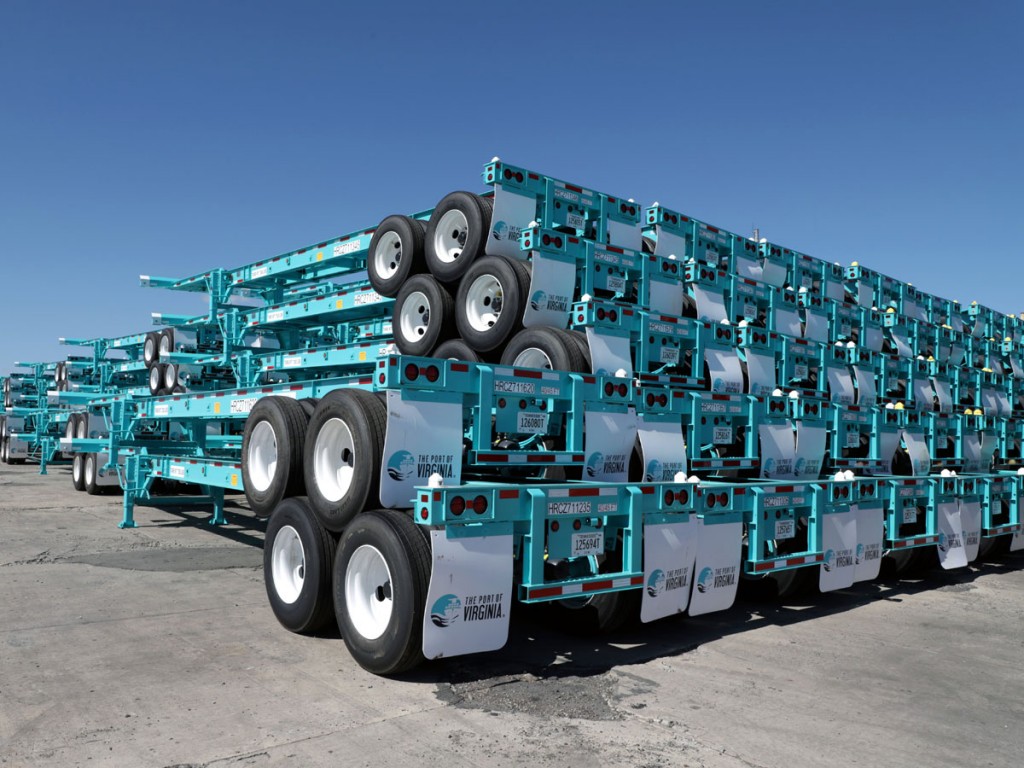Nearly 9,000 new chassis being added to HRCPII’s fleet through end of fy21
Oct 06, 2020The Port of Virginia’s continual investment in new equipment is helping to build one of the youngest chassis fleets in the nation, with the average age of chassis in the port’s pool being 3.5 years old.
Experts in the field estimate the average age of an intermodal chassis to be 15-years to 20-plus-years-old. But with a continual cycle of adding new units and retiring old ones, the port is ensuring a young, safe, road-worthy chassis fleet for the motor carriers servicing the port.

In fiscal year 2020 (July 1, 2019 – June 30, 2020), Hampton Roads Chassis Pool II, the port’s wholly-owned chassis management and empty container yard management entity, added 3,600 new chassis to its fleet. In fiscal year 2021, 5,000 more new units will be put into service and 760 new units are scheduled for delivery in 2022. Moreover, 60 percent of the chassis in the fleet have been acquired since 2015.
“The effort to keep the fleet young reduces down-time for maintenance and helps keep repairs to a minimum,” said John F. Reinhart, CEO and executive director of the Virginia Port Authority. “With the additional acquisitions planned during FY21, we’ll have one of the youngest chassis pool fleets in the industry. Current plans for FY21 will advance our renewal process to 95 percent completion.”
In addition to rotating new chassis into service and retiring older units, HRCPII uses technology to provide visibility into the status of its chassis and manage maintenance. The program, provided by a
private vendor, helps identify predictive, preventative, or corrective maintenance to ensure that chassis are serviced on a regular schedule.
“The goal is to provide safe and road-ready chassis to the motor carriers servicing The Port of Virginia and use of technology really helps in our effort,” said Arthur W. Ellermann, HRCP II’s managing director. “Technology helps minimize downtime, gathers important data, and allows us to make informed decisions on the usable life-cycle of the chassis in a pool environment.”
The addition of new chassis and use of predicative maintenance has led to a 50-percent reduction in over-the-road downtime for chassis and the number of out-of-service units is averaging 1.5 percent, Ellermann said.
“As newer, safer chassis go out onto the road, we’re reducing risk for our partners, customers and the driving public,” Reinhart said. “We’re also creating -- and committing to -- better reliability for the motor carriers and our beneficial cargo owners.”
Similar Stories

FTR Reports October U.S. Trailer Net Orders at 15,970 units below expectations
View ArticleRail Vision unveils innovative active control system, enabling semi-autonomous locomotive capabilities
The system will be deployed as part of the initial rollout on the fleet of one of its leading U.S customers, with implementation starting by the end of 2024
View ArticleWallenius Wilhelmsen prepares for a net-zero future with a new multi-fuel price mechanism
Bunker Adjustment Factor (BAF) is a pricing mechanism used to adjust freight rates based on fuel price fluctuations. On the path to net-zero emissions by 2040, greater clarity around the…
View Article
Biden-Harris Administration announce nearly $1.5 billion in additional upgrades to America’s busiest rail corridor
View Article
Schneider recognized as a Top Company for Women to Work in Transportation for sixth consecutive year
View Article
NCCC announces tentative national agreement with SMART-MD
View ArticleGet the most up-to-date trending news!
SubscribeIndustry updates and weekly newsletter direct to your inbox!





